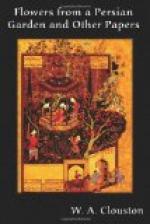[76] Among the Muhammedan legends
concerning Solomon and the
Queen
of Sheba, it is related that, after he had
satisfactorily
answered all her questions and solved her
riddles,
“before he would enter into more intimate
relations
with her, he desired to clear up a certain
point
respecting her, and to see whether she actually
had
cloven feet, as several of his demons would have him
to
believe; or whether they had only invented the defect
from
fear lest he should marry her, and beget children,
who,
as descendants of the genii [the mother of Bilkis
is
said to have been of that race of beings], would be
even
more mighty than himself. He therefore caused
her
to
be conducted through a hall, whose floor was of
crystal,
and under which water tenanted by every variety
of
fish was flowing. Bilkis, who had never seen a
crystal
floor, supposed that there was water to be
passed
through, and therefore raised her robe slightly,
when
the king discovered to his great joy a beautifully
shaped
female foot. When his eye was satisfied, he
called
to her: ’Come hither; there is no water
here, but
only
a crystal floor; and confess thyself to the faith
in
the one only God.’ Bilkis approached the
throne,
which
stood at the end of the hall, and in Solomon’s
presence
abjured the worship of the sun. Solomon then
married
Bilkis, but reinstated her as Queen of Saba, and
spent
three days in every month with her.”
The Arabians and Persians, who have many traditions regarding Solomon, invariably represent him as adept in necromancy, and as being intimately acquainted with the language of beasts and birds. Josephus, the great Jewish historian, distinctly states that Solomon possessed the art of expelling demons, that he composed such incantations also by which distempers are alleviated, and that he left behind him the manner of using exorcisms, by which they drive out demons, never to return. Of course, Josephus merely reproduces rabbinical traditions, and there can be no doubt but the Arabian stories regarding Solomon’s magical powers are derived from the same source. It appears that Solomon’s signet-ring was the chief instrument with which he performed his numerous magical exploits.[77] By its wondrous power he imprisoned Ashmedai, the prince of devils; and on one occasion the king’s curiosity to increase his store of magical knowledge cost him very dear—no less than the loss of his kingdom for a time. Solomon was in the habit of daily plying Ashmedai with questions, to all of which the fiend returned answers, furnishing the desired information, until one day the king asked him a particular question which the captive evil spirit flatly refused to answer, except on condition that Solomon should




